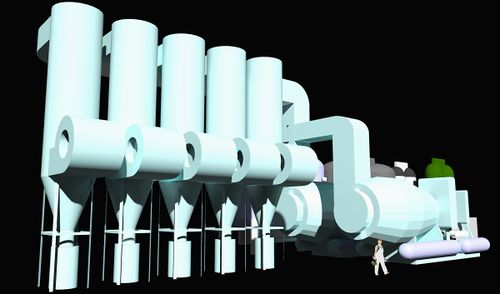Dust collector
A dust collector is a device used to separate dust from air in an atmospheric processing system. In some cases clean air is the desired result, in others, the dust is the object of interest.
Most dust collectors operate below atmospheric pressure with the fan on the clean side, after the dust separation system. In the thin martian atmosphere, the available pressure is very low, much lower than the standard operating pressure of dust collectors. So the fan might be required to be put on the dusty side, before the filters.
Dust collectors are filtration systems. For effective filtration of small particles they will often operate in cascade fashion, with a pre-filter and secondary filters.
In the first stage, cyclonic separation, a type of inertial separation, can remove a large fraction of the heavier particles.[1]
HEPA grade filters can filter down to 5 microns, removing bacteria. However they have no effect on gases, only dust and particulate matter.[2]
Electrostatic precipitators[3] might be more effective than filters in removing the fine particulates in the martian atmosphere, and are part of most process proposals.
Dust collectors might be used in a number of cases:
- Extraction of in situ resources from the martian atmosphere.
- Cabin filtration in vehicles.
- Airlock pump down systems.
- Interior air filtration of a settlement.
- Interior air filtration of settlement production facilities.
The background (average) dust loading of Mars is estimated at 1,8e-7 kg/m3[4]. A dust collector treating 1 kg/s of martian atmosphere, about 50 m3/s, would need to remove 283 kg of dust per year. This would be sufficient to produce the propellant for 40 Starship type vehicles. So for a single vehicle about 7 kg per year would need to be removed from about 1,1 m3/s (2400 cfm).
| Dust collection | average background | |
| Volume flow rate | m3/s | 50 |
| dust loading | kg/m3 | 1.80E-07 |
| dust capture | kg/s | 9.00E-06 |
| per day | s | 86400 |
| kg/day | 7.78E-01 | |
| per year | kg/year | 283.82 |
These figures would go up during dust storms, except for a solar powered settlement that would probably need to cut back on propellant production during storms.
The MEDUSA instrument[5], part of ESA EXO Mars 2020 mission, is designed to measure in situ the dust conditions of the Martian atmosphere.
Electrostatic dust collectors
An alternative to cartridges and bag filters is the use of electrostatic separators, that do not require air pressure differences to operate[1].
References
- ↑ 1.0 1.1 Chepko, Ariane, Michael Swanwick, Paul Sorensen, and Darius Modarress. "Two-Stage Dust Removal System for Mars In-Situ Resource Utilization Systems: System Sizing and Trade-offs." 48th International Conference on Environmental Systems, 2018.
- ↑ https://www.hou.usra.edu/meetings/marsdust2017/pdf/6016.pdf
- ↑ https://iopscience.iop.org/article/10.1088/1742-6596/327/1/012048/pdf
- ↑ https://pdfs.semanticscholar.org/418a/88f31b87f3d615a1f6116d31a078cfde8802.pdf
- ↑ https://pdfs.semanticscholar.org/418a/88f31b87f3d615a1f6116d31a078cfde8802.pdf







